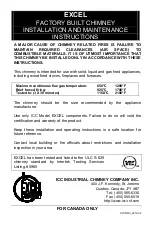
Calibration Mode
(
continued
)
Calibration Mode Procedure
(figure 17):
l
If it is suspected that hydrogen sulfide
gas is present, it will be necessary to
purge the sensor with clean air.
l
Place the magnet over the GMI logo on
the cover of the unit and hold it there
(about ten seconds) until
AC
appears in the display
window. Then remove the
magnet.
l
Apply a concentration of H
2
S
gas, equivalent to 50% of full
scale, to the sensor. The
display will change from
AC
to
CP
indicating that the
sensor is responding to the
gas.
l
After three to five minutes the
display will change from
CP
to
CC
indicating that the
calibration is complete.
Remove the calibration gas
and allow the sensor to see
clean air. The display will
change from
CC
to indicate a
few parts per million (ppm)
and then drop to
0
.
l
The unit is now calibrated and
the new values have been stored in the
EEPROM (non-volatile memory).
General Monitors recommends that the
Model S216A be calibrated within the first
hour of operation after the initial application
of power and that a second calibration be
performed 24 hours after this initial
calibration. These two calibration sequences
should be performed with new units and
units that have been off of power for more
than a week.
The Model S216A can be returned to normal
operation if the magnet is re-applied after
ninety seconds of initiating the calibration
sequence.
If the Model S216A is placed in the
calibration mode and no gas is applied for
twelve minutes, the unit will revert to a fault
condition. Placing the magnet over the GMI
Logo again will return the unit to the
calibration mode. Re-applying the magnet
after ninety seconds will return the Model
S216A to normal operation using the
previous set of calibration values. If there is
a problem and the Model S216A Smart
Sensor cannot complete the calibration
sequence, the unit will display a fault code
and the output will drop to zero.
The Model S216A will indicate an “
F1
” if
the sensor is too responsive, an “
F3
” if the
sensor is not sensitive enough, an “
F2
” if
the total calibration interval has been
exceeded, or an “
F7
” if the calibration
values were not properly stored in the
EEPROM. These and other fault codes are
explained in section 4.8 Fault Codes and
Their Remedies.
NOTE: If the unit fails to calibrate an
“F” code will be displayed. The
calibration gas should be removed from
the sensor and the sensor must “see”
clean air for at least five minutes before a
second calibration is attempted by re-
applying the magnet. The possible
reasons for an unsuccessful calibration
are covered in section 4.8 Fault Codes and
Trouble Shooting.
4.4
Cali bra tion Equip ment
17
fig ure 17
Model S216A
Operation
Summary of Contents for S216A
Page 3: ...anytime the system power is off for more than an hour ...
Page 7: ...2 General Monitors ...
Page 11: ...6 General Monitors ...
Page 19: ...General Monitors 14 ...
Page 31: ...26 General Monitors ...
Page 34: ...29 Model S216A Appendix fig ...
















































